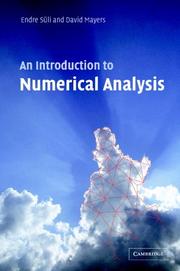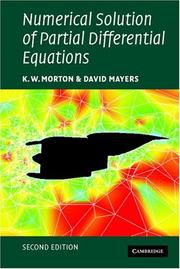| Listing 1 - 9 of 9 |
Sort by
|
Book
Abstract | Keywords | Export | Availability | Bookmark
 Loading...
Loading...Choose an application
- Reference Manager
- EndNote
- RefWorks (Direct export to RefWorks)
Book
Abstract | Keywords | Export | Availability | Bookmark
 Loading...
Loading...Choose an application
- Reference Manager
- EndNote
- RefWorks (Direct export to RefWorks)
Book
Abstract | Keywords | Export | Availability | Bookmark
 Loading...
Loading...Choose an application
- Reference Manager
- EndNote
- RefWorks (Direct export to RefWorks)
Book
Abstract | Keywords | Export | Availability | Bookmark
 Loading...
Loading...Choose an application
- Reference Manager
- EndNote
- RefWorks (Direct export to RefWorks)
Book
Abstract | Keywords | Export | Availability | Bookmark
 Loading...
Loading...Choose an application
- Reference Manager
- EndNote
- RefWorks (Direct export to RefWorks)

ISBN: 0521810264 0521007941 9780521007948 9780521810265 9780511801181 Year: 2003 Publisher: Cambridge Cambridge University Press
Abstract | Keywords | Export | Availability | Bookmark
 Loading...
Loading...Choose an application
- Reference Manager
- EndNote
- RefWorks (Direct export to RefWorks)
This textbook is written primarily for undergraduate mathematicians and also appeals to students working at an advanced level in other disciplines. The text begins with a clear motivation for the study of numerical analysis based on real-world problems. The authors then develop the necessary machinery including iteration, interpolation, boundary-value problems and finite elements. Throughout, the authors keep an eye on the analytical basis for the work and add historical notes on the development of the subject. There are numerous exercises for students.
Numerical analysis. --- Numerical analysis --- Mathematical analysis

ISBN: 9780521607933 0521607930 9780511812248 Year: 2005 Publisher: Cambridge Cambridge University Press
Abstract | Keywords | Export | Availability | Bookmark
 Loading...
Loading...Choose an application
- Reference Manager
- EndNote
- RefWorks (Direct export to RefWorks)
This is the second edition of a highly successful and well-respected textbook on the numerical techniques used to solve partial differential equations arising from mathematical models in science, engineering and other fields. The authors maintain an emphasis on finite difference methods for simple but representative examples of parabolic, hyperbolic and elliptic equations from the first edition. However this is augmented by new sections on finite volume methods, modified equation analysis, symplectic integration schemes, convection-diffusion problems, multigrid, and conjugate gradient methods; and several sections, including that on the energy method of analysis, have been extensively rewritten to reflect modern developments. Already an excellent choice for students and teachers in mathematics, engineering and computer science departments, the revised text brings the reader up-to-date with the latest theoretical and industrial developments.
519.63 --- 519.63 Numerical methods for solution of partial differential equations --- Numerical methods for solution of partial differential equations --- Partial differential equations: difference methods; elliptic equations; finite element methods; hyperbolic equations; method of lines; parabolic equations (Numerical analysis) --- 681.3 *G18 Partial differential equations: difference methods; elliptic equations; finite element methods; hyperbolic equations; method of lines; parabolic equations (Numerical analysis) --- Differential equations, Partial --- 519.65 --- 681.3 *G18 --- 519.65 Approximation. Interpolation --- Approximation. Interpolation --- Numerical analysis --- Numerical solutions --- Numerical solutions. --- Differential equations, Partial - Numerical solutions

ISBN: 1107132290 1139636901 0511078102 0511801181 051120440X 0511561539 0511076533 9780511078101 9780511076534 9780511801181 9780511204401 0521810264 9780521810265 0521007941 9780521007948 Year: 2003 Publisher: Cambridge : Cambridge University Press,
Abstract | Keywords | Export | Availability | Bookmark
 Loading...
Loading...Choose an application
- Reference Manager
- EndNote
- RefWorks (Direct export to RefWorks)
Numerical analysis provides the theoretical foundation for the numerical algorithms we rely on to solve a multitude of computational problems in science. Based on a successful course at Oxford University, this book covers a wide range of such problems ranging from the approximation of functions and integrals to the approximate solution of algebraic, transcendental, differential and integral equations. Throughout the book, particular attention is paid to the essential qualities of a numerical algorithm - stability, accuracy, reliability and efficiency. The authors go further than simply providing recipes for solving computational problems. They carefully analyse the reasons why methods might fail to give accurate answers, or why one method might return an answer in seconds while another would take billions of years. This book is ideal as a text for students in the second year of a university mathematics course. It combines practicality regarding applications with consistently high standards of rigour.
Book
ISBN: 0511111622 9780511111624 9780511197666 9780511111297 0511111290 0511197667 1139930567 1107127653 0511812248 0511555989 Year: 2005 Publisher: Cambridge ; New York : Cambridge University Press,
Abstract | Keywords | Export | Availability | Bookmark
 Loading...
Loading...Choose an application
- Reference Manager
- EndNote
- RefWorks (Direct export to RefWorks)
This is the 2005 second edition of a highly successful and well-respected textbook on the numerical techniques used to solve partial differential equations arising from mathematical models in science, engineering and other fields. The authors maintain an emphasis on finite difference methods for simple but representative examples of parabolic, hyperbolic and elliptic equations from the first edition. However this is augmented by new sections on finite volume methods, modified equation analysis, symplectic integration schemes, convection-diffusion problems, multigrid, and conjugate gradient methods; and several sections, including that on the energy method of analysis, have been extensively rewritten to reflect modern developments. Already an excellent choice for students and teachers in mathematics, engineering and computer science departments, the revised text includes more latest theoretical and industrial developments.
Differential equations, Partial --- Numerical analysis --- Numerical solutions.
| Listing 1 - 9 of 9 |
Sort by
|

 Search
Search Feedback
Feedback About UniCat
About UniCat  Help
Help News
News